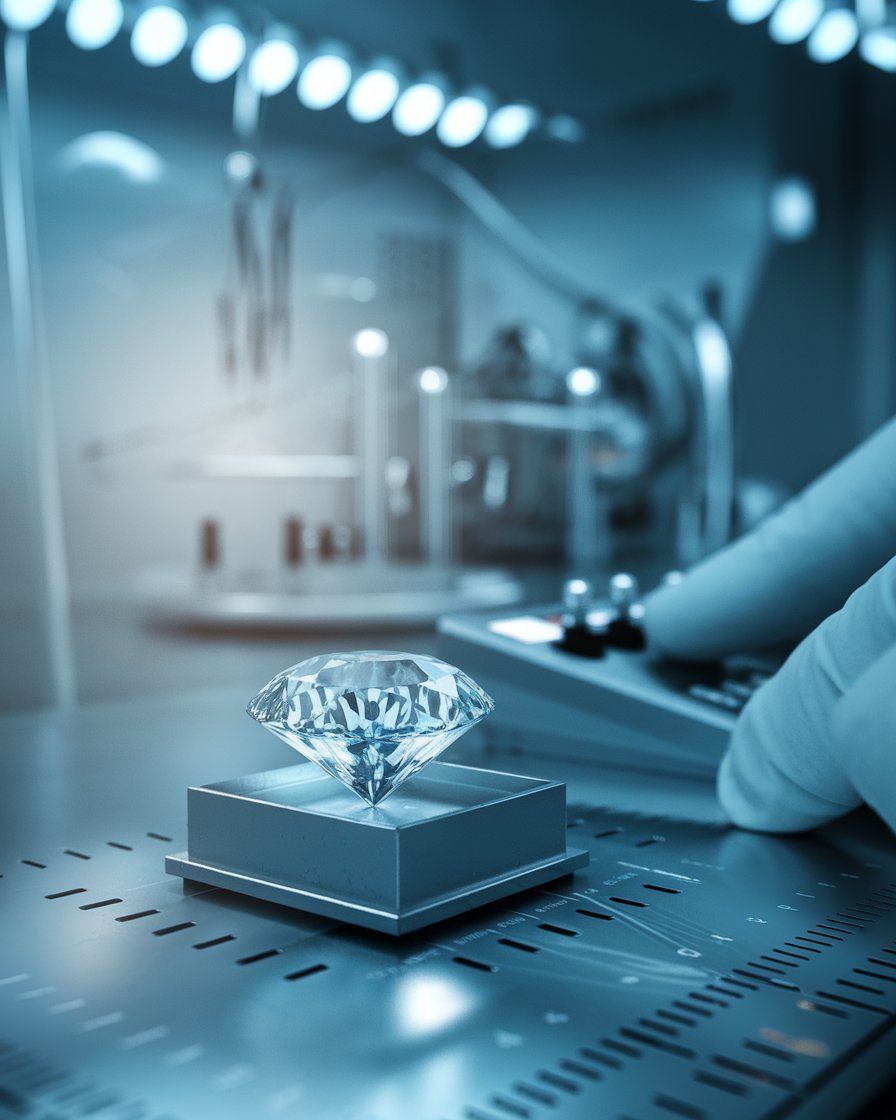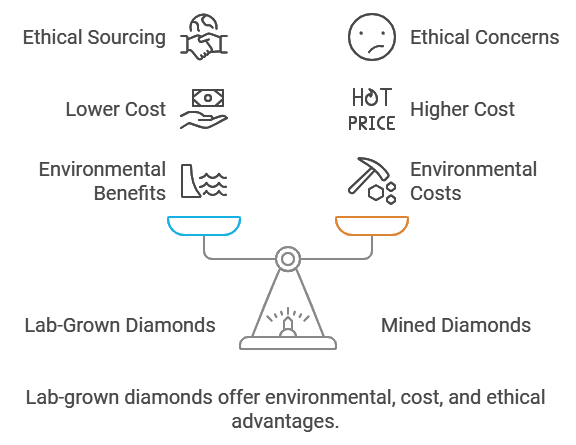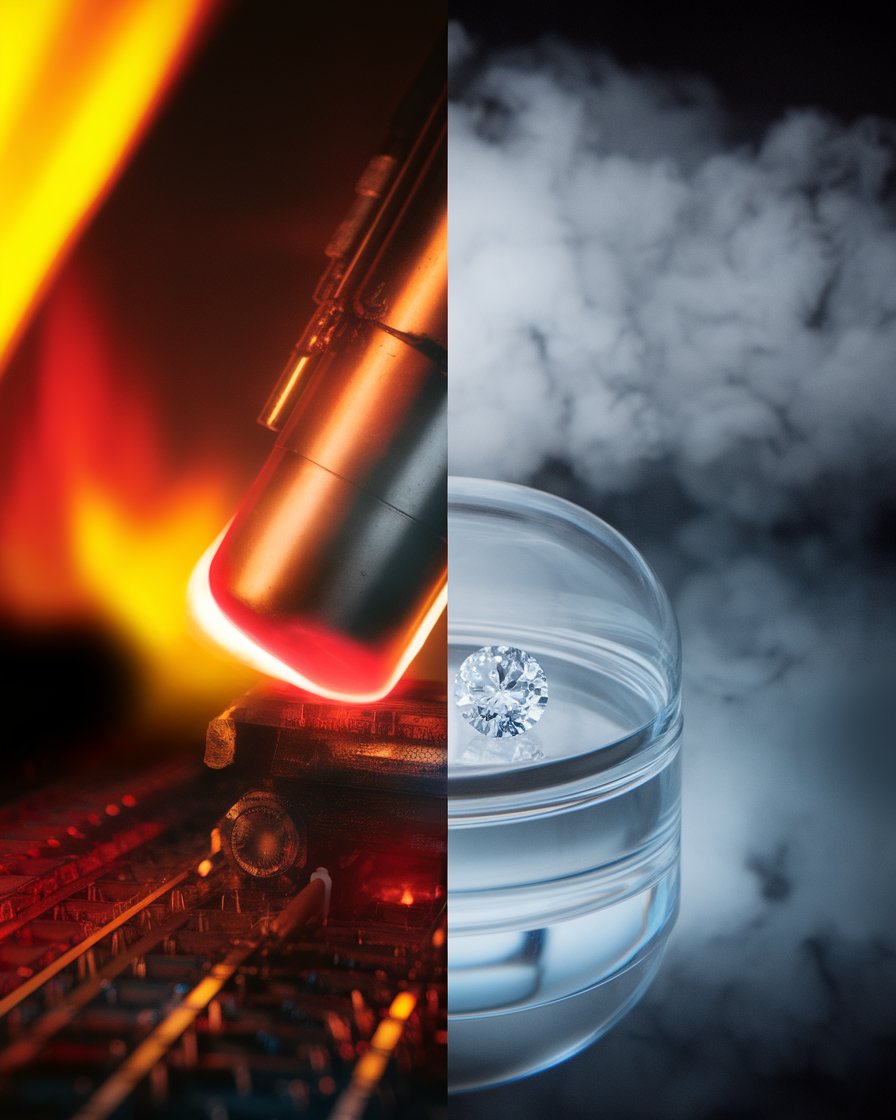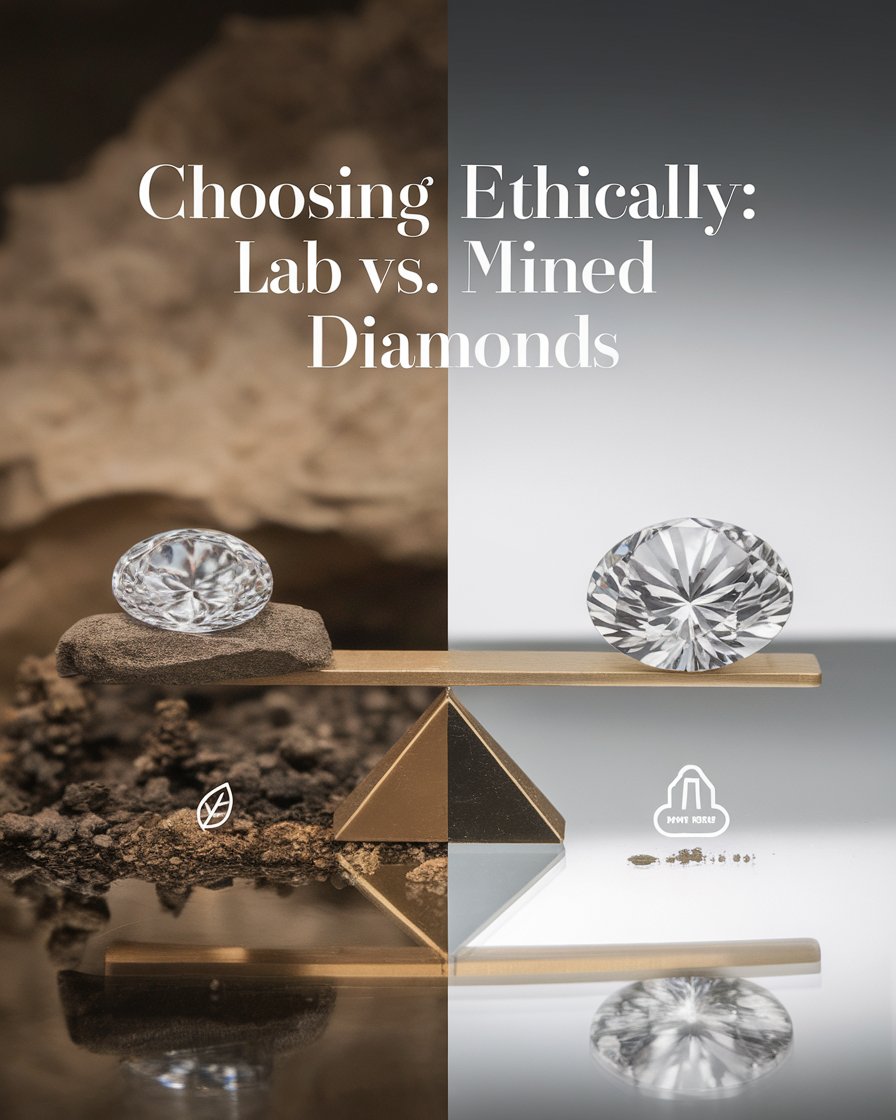Introduction
Lab-grown diamonds have become a popular choice for people who want an alternative to natural diamonds. Unlike mined diamonds that form over millions of years deep in the Earth, lab-grown diamonds are created in controlled settings where scientists make conditions just right for diamond formation. Using methods like HPHT (High Pressure High Temperature) and CVD (Chemical Vapor Deposition), lab-grown diamonds take on the same physical structure as mined diamonds. That means they look just as brilliant and tough as the ones pulled from the Earth.
As lab-grown diamonds gain popularity, people are starting to appreciate the benefits they bring. These diamonds skip the whole mining process, making them a sustainable option that many find appealing. In this article, we’ll dive into how lab-grown diamonds are made, what sets HPHT diamonds apart from CVD diamonds, and why lab-created gems are shaping the future of the diamond market.
Key Takeaways
- Lab-grown diamonds form in labs using high-tech processes like HPHT and CVD.
- These diamonds have the same qualities as mined diamonds, from looks to durability.
- Lab-grown diamonds avoid mining, making them an eco-friendly choice.
- Choosing lab-grown diamonds supports sustainable practices without losing out on sparkle.
- Rising demand for lab-created diamonds is nudging the diamond industry toward greener methods.
- Lab-grown diamonds are more affordable and offer a high-quality option for eco-friendly buyers.
Understanding the Science Behind Lab-Grown Diamonds
Lab-grown diamonds are created in controlled environments, mimicking the intense conditions that natural diamonds are formed within the Earth. Using high temperatures and pressures or a carbon-rich gas chamber, these diamonds grow from a small diamond seed of carbon, much like their natural counterparts. This process allows diamond producers to make diamonds with the same physical, chemical, and optical properties as mined diamonds. By understanding how lab grown diamonds and lab created diamonds are made, consumers can see them as identical to natural diamonds, offering a sustainable and ethical option. This knowledge helps diamond owners make informed decisions, appreciating both the scientific achievements and the environmental benefits of synthetic diamonds.
How Lab-Grown Diamonds Mimic Natural Formation
Lab-grown diamonds begin with a diamond seed crystal, usually a small piece of carbon. In a controlled environment, the diamond seed is placed under conditions that replicate Earth’s natural diamond formation process. The carbon atoms bond in a crystal structure, producing lab grown diamonds that share the same hardness, brilliance, and physical properties as natural diamonds. By mimicking nature, this process ensures that diamonds are identical to those mined from the Earth, appealing to those who value ethical options without compromising quality.
Benefits of Choosing Lab-Grown Diamonds
Choosing lab-grown diamonds brings several advantages, from ethical sourcing to cost savings. These diamonds avoid the environmental impact of mining, offering a responsible alternative for eco-conscious buyers. Additionally, lab diamonds take on a lower price point, making them accessible without sacrificing quality. As diamonds are real diamonds with identical chemical makeup to mined stones, lab-grown options give consumers the same sparkle and durability. This appeal strengthens their position among those seeking both value and sustainability in jewelry, including those considering a diamond ring or even a diamond engagement ring.
Essential Insights into Lab-Grown Diamonds
1. The Science Behind Lab-Grown Diamonds
Lab-grown diamonds start as small carbon seeds and grow under intense conditions. This process produces lab-created diamonds with the same structure as mined diamonds, blending technology with nature’s touch.
2. Environmental Advantages of Lab-Created Diamonds
Lab-grown diamonds skip the mining process, reducing soil disturbance and saving water. This makes them an appealing choice for eco-conscious buyers who want lab-grown diamonds without the environmental cost.
3. Understanding HPHT and CVD Methods
The HPHT method uses high pressure and heat to create diamonds, while CVD diamonds are made with carbon gas that layers onto a seed. Both methods create durable diamonds, but each has its strengths.
4. Cost and Accessibility of Lab-Grown Diamonds
Lab-grown diamonds tend to cost less than mined ones, offering a budget-friendly option without skimping on quality. This makes them a smart choice for many buyers.
5. Ethical Appeal of Lab-Grown Options
For those seeking ethically sourced gems, lab-grown diamonds stand out. Lab-grown diamonds are created under fair and safe conditions, making them a responsible pick for buyers with ethical priorities.
The Process of Growing Diamonds: HPHT vs. CVD
Two main methods, HPHT (High Pressure High Temperature) and CVD (Chemical Vapor Deposition), allow man made diamond production in laboratories. HPHT replicates natural Earth-like conditions, with carbon exposed to extreme heat and pressure, forming a rough diamond within that can be polished for jewelry. CVD, on the other hand, uses carbon gas to deposit onto a diamond seed within a sealed chamber, gradually building the diamond layer by layer. These technologies not only shorten the time needed to create a lab diamond but also offer a more sustainable alternative to traditional diamond mining. Choosing between HPHT and CVD depends on desired qualities, as each method provides distinct benefits for lab diamond enthusiasts who seek options like natural diamonds.
High Pressure High Temperature (HPHT) Method
The HPHT method for creating diamonds involves making lab diamonds by placing carbon inside a machine that applies immense pressure and heat, similar to the conditions deep within the Earth’s crust. This environment encourages the carbon atoms to arrange into a crystal structure, forming a rough diamond. HPHT diamonds are known for their high clarity and are often used for industrial purposes or jewelry. This method’s precise conditions ensure that diamonds possess durability, vibrant color, and a likeness to natural gems, making them a preferred choice for some diamond producers.
Chemical Vapor Deposition (CVD) Diamond Formation
CVD diamonds are formed by exposing a diamond seed to carbon-rich gas inside a chamber. When heated, this gas breaks down, depositing carbon atoms onto the seed and allowing the diamond to grow layer by layer. This process is efficient, producing high-quality diamonds relatively quickly. CVD diamonds often have consistent quality, and their creation involves fewer resources than traditional mining, positioning them as an ethical choice. The CVD method has become popular for producing diamonds used in both jewelry and technology, valued for its precision and eco-friendly nature.
Case Study: Adapting HPHT and CVD in the Diamond Industry
Diamond Foundry, a California company, sets a prime example by creating lab-grown diamonds with both the HPHT and CVD processes. Using advanced technology, Diamond Foundry makes lab-grown diamonds that mirror natural ones in both structure and shine. By leveraging the CVD process, Diamond Foundry can keep quality steady, answering the call for eco-friendly and ethically produced gems. The company’s focus on reducing its environmental impact shows how lab-grown diamonds are becoming more than just an option—they’re part of a trend towards responsible luxury.
Through this approach, Diamond Foundry gives consumers a chance to buy diamonds made without the environmental and ethical concerns linked to mining. Diamond Foundry’s case highlights the broader industry shift, as lab-grown diamonds find a lasting spot in the jewelry market for conscious consumers.
Lab-Grown Diamonds vs. Natural Diamonds: Ethical and Environmental Considerations
Lab-grown diamonds have emerged as a popular ethical alternative to mined diamonds. Unlike natural and lab diamonds, which require extensive mining and have a notable environmental impact, lab grown diamonds are created in specialized settings that limit ecological disruption. This controlled production results in diamonds that, although manufactured, possess properties as natural diamonds, making them a valuable choice for those concerned with sustainability. Furthermore, lab diamonds typically come at a lower cost, providing consumers with an affordable option without sacrificing quality. For those who value ethical sourcing, lab grown and natural diamonds stand out as a responsible choice that aligns with environmental and ethical priorities.
Environmental Impact of Diamond Mining vs. Lab Creation
Mining diamonds involves significant land disturbance, water usage, and energy consumption. In contrast, lab-grown diamonds are created in closed environments that use fewer resources, reducing their environmental footprint. This lower-impact process appeals to eco-conscious consumers who prioritize sustainability. By choosing lab-grown diamonds, buyers can avoid the ecological costs associated with traditional mining, supporting an industry shift toward more ethical practices. Lab-grown diamonds offer a compelling alternative, both ethically and environmentally.
Ethical Sourcing and Consumer Choices
For those concerned with ethical sourcing, lab-grown diamonds provide peace of mind. Natural diamond mining often involves complex labor issues and environmental challenges, while lab-grown diamonds are created under controlled, humane conditions. This transparency in the sourcing process reassures buyers who seek ethical options. Consumers now have more choices than ever, allowing them to select diamonds that align with their values. Lab-grown diamonds have thus become an attractive option for individuals who prioritize ethical and sustainable jewelry.
“Sustainable choices are no longer just a trend but a responsibility we carry. In selecting lab-grown diamonds, we’re choosing not just beauty but also a commitment to ethical practices and environmental stewardship.”
— Leonardo DiCaprio, environmental advocate and investor in sustainable technologies
Future of Lab-Grown Diamonds in the Diamond Market
As technology advances, lab diamonds are made to play an increasingly significant role in the diamond industry. These diamonds not only meet high standards for quality and appearance but also appeal to a growing market segment focused on ethical and sustainable jewelry options. With expanding consumer awareness and acceptance, lab-grown diamonds may reshape industry practices and pricing models. Their introduction has led to shifts in consumer preferences, particularly for those who value environmentally conscious choices. This evolving market reflects a broader trend toward sustainability, with lab diamonds created to remain an influential option for both new buyers and traditional diamond enthusiasts.
Market Demand and Consumer Trends for Lab-Grown Diamonds
The demand for lab-grown diamonds has surged as awareness grows around ethical and sustainable jewelry options. More consumers are choosing lab diamonds due to their affordability and environmental benefits. This shift in consumer preferences is reshaping the diamond market, influencing traditional jewelers to incorporate lab-grown options. Market trends suggest that lab-grown diamonds will continue to gain popularity, driven by a younger generation prioritizing sustainability and value over tradition.
Potential Shifts in Diamond Pricing and Valuation
Lab-grown diamonds are causing a ripple effect on diamond pricing and perceived value. With lab diamonds providing an affordable alternative, the industry may see changes in how both lab-grown and natural diamonds are priced. This could lead to greater accessibility for buyers and possibly influence the long-term valuation of natural diamonds. As lab-grown options gain acceptance, their market impact continues to grow, potentially redefining consumer perceptions and the future pricing landscape for diamond jewelry.
Conclusion
Lab-grown diamonds have brought a new dimension to the jewelry industry, offering an ethical and sustainable alternative to traditional mined diamonds. With advanced methods like HPHT and CVD, these diamonds not only match the visual and structural qualities of natural diamonds but also provide an option that aligns with environmental values. For many buyers, lab-grown diamonds represent a blend of scientific innovation and responsible sourcing, allowing them to enjoy the beauty of real diamonds without the environmental toll.
As consumer awareness grows, lab-grown diamonds are likely to gain even more traction in the market, reshaping industry standards and buyer expectations. Whether chosen for their lower cost, environmental benefits, or ethical production, these diamonds continue to appeal to those seeking both quality and peace of mind. Embracing lab-grown diamonds could well be a step toward a more sustainable future for the diamond industry and its enthusiasts.

















